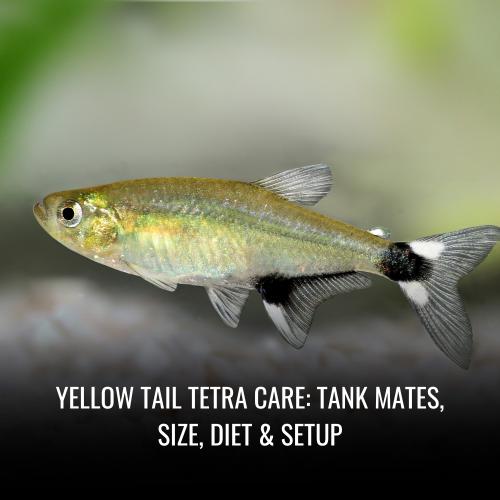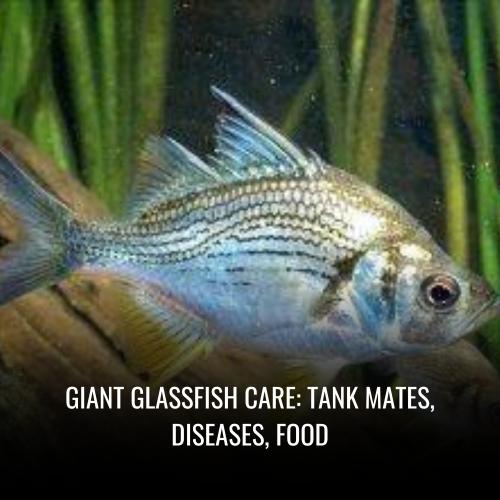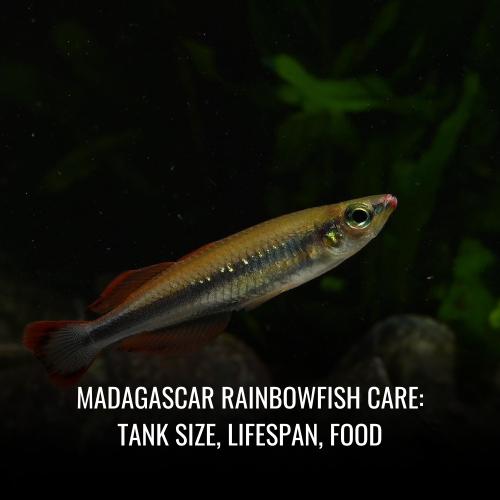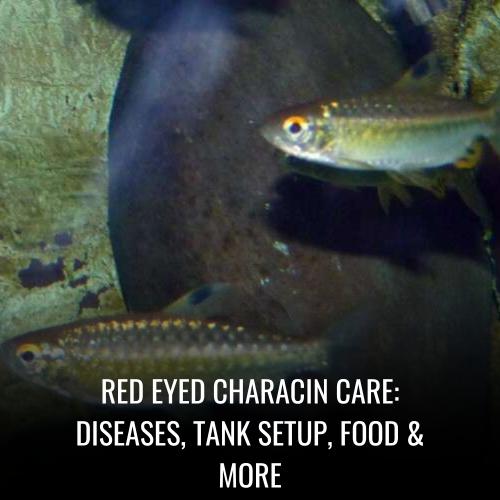Bronze Cory Care: Size, Tank Mates, Diet, Setup & More
This post contains affiliate links. As an Amazon Associate, we earn from qualifying purchases.
The Bronze Cory, scientific name Corydoras aeneus, is a peaceful schooling fish hailing from South America. Its natural habitat spans from Colombia to the River Plate, thriving in shallow rivers with muddy substrates. Recognized for their dexterous scavenging, these corydoras are a staple in freshwater aquariums, compatible with various non-aggressive species.
As they mature, their shimmering green and orange hues give them a captivating view. Bronze Corys are bottom feeders, often seen foraging with zeal, which aids in substrate cleaning. They are well-suited for community tanks due to their amiable nature towards others.
Bronze Cory Quick Facts
| Fact | Detail |
|---|---|
| Scientific Name | Corydoras aeneus |
| Common Name | Bronze Cory |
| Family | Callichthyidae |
| Usual Size in Tanks | 2.5-3 inches |
| pH Range | 6.0-7.8 |
| Water Hardness | 2-25 dGH |
| Preferred Temperature | 72-79°F (22-26°C) |
| Reproduction | Egg-layers |
| Origin | South America |
| Temperament | Peaceful |
| Tank Position | Bottom dweller |
| Lifespan | Up to 5 years |
| Minimum Tank Size | 20 gallons |
| Filtration System | Required |
| Sexual Dimorphism | Females larger & rounder |
These armored catfishes should be kept in groups and provided a varied diet, including high-quality flake food and pellet food, supplemented with frozen foods such as brine shrimp for optimal health.
Scientific Name
The Bronze Cory, known to enthusiasts by its scientific moniker Corydoras aeneus, belongs to the freshwater catfish family and calls the tropical waters of South America its home. This species extends its natural range from the riverbanks of Colombia to the serene waters of Trinidad.
The significance of its scientific name is undeniable. It not only distinguishes the Bronze Cory from other fish but also sheds light on its lineage within the Corydoras genus. “Aeneus,” hailing from Latin, hints at its iridescent bronze coloration—a key feature drawing in aquarists.
Acting as a universal language, the scientific name unites hobbyists, scientists, and conservationists around the globe. It ensures clarity and uniformity across various disciplines, enabling everyone to speak the same biological language.
Average Size
Bronze Corydoras, also known as Bronze Corys or Bronze Catfish, are a modestly sized and favored addition to many home aquariums. The typical adult size of these peaceful schooling fish ranges between 2.6 to 3 inches (6.5 – 7.5 cm). Even within this range, there are slight variations between the sexes: females are generally slightly larger and possess a fuller body frame, particularly noticeable around the abdominal area.
Here’s a quick rundown of the size differences:
- Males: Usually up to 2.5 inches (6.5 cm)
- Females: Can grow up to 2.75 inches (7 cm)
These beloved armored catfishes, with their longevity, often become a long-term commitment for aquarium enthusiasts. A Bronze Cory can live up to an impressive 10 years when provided with high-quality flake food, a suitable environment, and proper care. Exceptional cases have seen these resilient freshwater inhabitants surpass the decade mark, showcasing their enduring nature in a home tank.
Lifespan
Bronze Corydoras are remarkable for their relatively long lifespan in the freshwater aquarium setting. On average, these tranquil schooling fish can grace your tank for up to 10 years. Interestingly, female Bronze Corys often outlive their male counterparts, adding a subtle distinction in longevity between the sexes.
Proper care is paramount to ensure these fish reach such seniority. A meticulously cared-for tank, complementing their natural South American shallow waters habitat, supports their health and longevity. Key contributing factors are:
- Water Quality: Maintaining clean, well-filtered, and stable water parameters.
- Tank Size: Providing sufficient space by the minimum tank size recommendations.
- Diet: A balanced diet of high-quality flake food, pellet food, and occasional frozen foods like brine shrimp.
To combat stress, avoid overcrowded conditions and aggressive tankmates, as Bronze Corys thrive in a tranquil environment with other peaceful and similarly sized fish. With such considerations in place, your Bronze Corydoras may not only live a fulfilled life but can thrive, potentially surpassing the decade mark in a lovingly curated freshwater aquarium.
Natural Habitat
The Corydoras catfish, a popular and peaceful schooling fish native to South America, thrives in their distinct shallow water habitat. They are commonly found in slow-moving streams and ponds with soft, muddy bottoms—environments that often experience low oxygen levels due to disturbed sediment.
Water Conditions in Corydoras Habitat
| Parameter | Range |
|---|---|
| Temperature | 25°C to 28°C (77°F to 82.4°F) |
| pH Levels | 6.0 to 8.0 |
| Water Hardness | 5 to 19 DGH |
These adaptable catfish, also known as Bronze Corys (Corydoras aeneus), adjust well to various water conditions. They can survive in:
- Slightly acidic conditions, which align with the typical South American waters.
- Neutral to slightly alkaline pH, often seen in African water systems.
Their remarkable resilience is attributed partly to their unique ability to cope with oxygen-poor environments—a trait that sets them apart from many other freshwater aquarium inhabitants. In a tank setting, mimicking these conditions by maintaining appropriate water levels and parameters is key to replicating their natural living space, ensuring the health and comfort of these armored catfishes.
Appearance
The Bronze Cory, a member of the armored catfish family, is a dynamic display of colors and shades that reflect their mood, age, and social hierarchy. Upon arrival from shipping, they may display a muted palette, their vibrant hues faded due to stress. With care, their true colors emerge as they acclimate to their new surroundings.
Notable for their elongated, armored bodies, Bronze Corys exhibit a primary bronze hue with variations from light to deep shades, complemented by a greenish glimmer along their flanks. Their fins, mostly transparent, occasionally catch the light with whispers of orange or red tinges.
| Life Stage | Coloration |
|---|---|
| Juvenile | Less vibrant |
| Adult | Richer, more intense hues |
Enthusiasts must research beforehand, as juveniles and adults of Bronze Corydoras may present differently; females can also differ markedly from males. Knowledge of their possible appearances ensures better awareness and appreciation of these freshwater jewels in your aquarium.
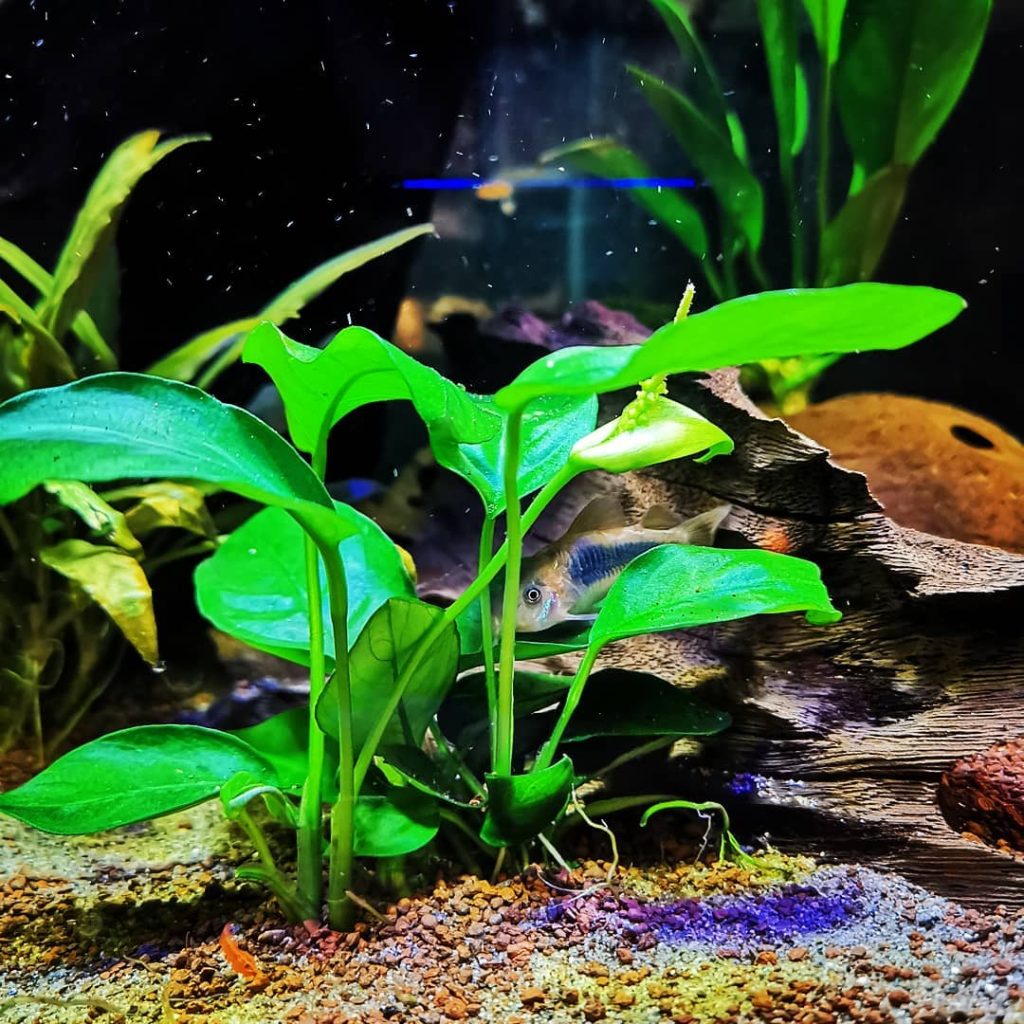
Behavior & Temperament
Bronze Corys, scientifically known as Corydoras aeneus, display a calm and gregarious demeanor that makes them an asset to any peaceful community aquarium. Native to the slow-moving rivers and stagnant waters of South America, these bottom-dwellers are renowned for their sociability, often found foraging the substrate in search of food during the day while also appreciating secure hideouts. They contribute a vibrant dynamic to the tank, with their day-time activity and endearing interactions with other tank inhabitants.
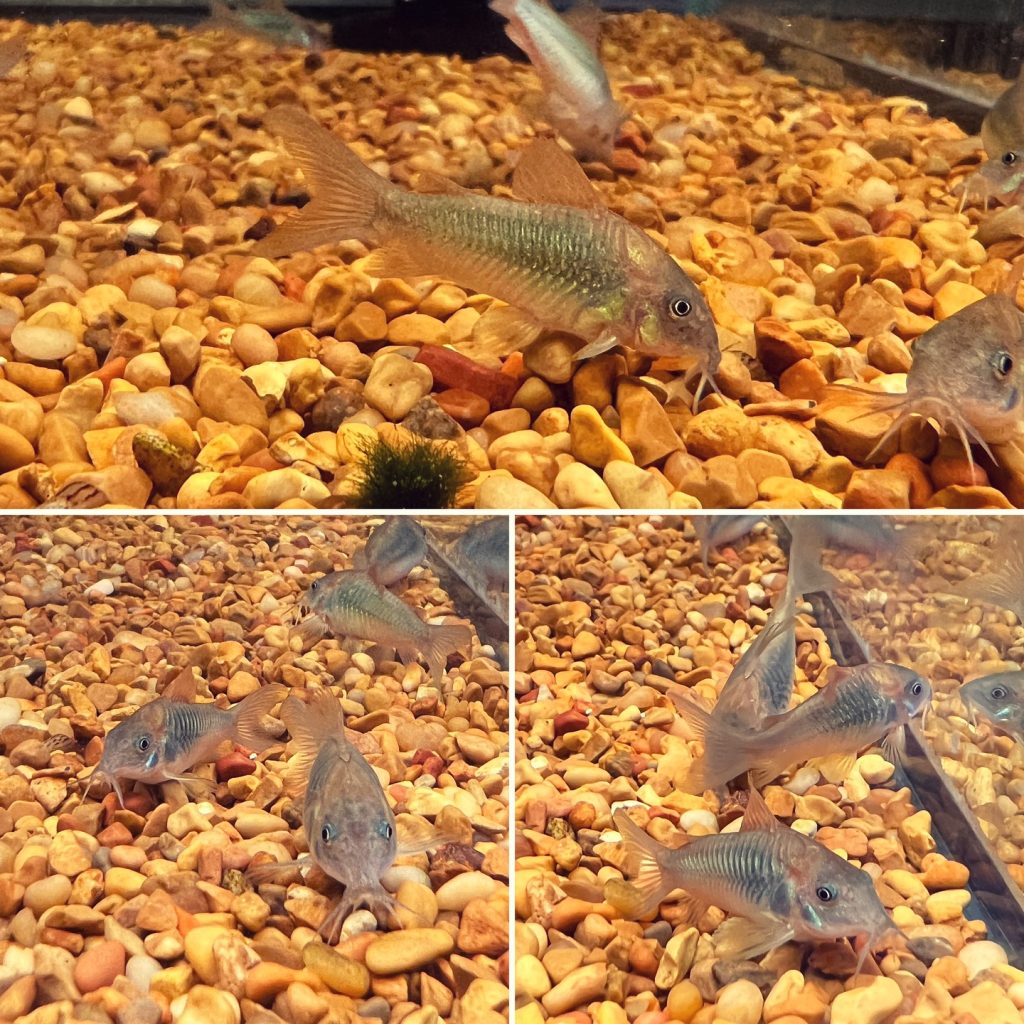
Are Bronze Cory Fin Nippers?
The Bronze Cory is far removed from the reputation of a fin nipper. These docile fish are well-regarded for their gentle nature and would rather spend their time sifting through the substrate than bothering their tank mates. Their non-aggressive feeding style and preference for pellets and high-quality flake food mean that they are not a threat to the other fish. An environment with ample space and food reduces any rare instances of fin-nipping behavior to practically nonexistent.
Are Bronze Cory Aggressive To Each Other & Other Fish?
The Bronze Cory’s personality is the epitome of peacefulness. They are not known to show aggression towards each other or other fish species. These charming members of the Corydoras genus thrive on companionship and exude a serene presence within the home aquarium. Their interactions are mostly harmonious, making them ideal residents for a community tank with other non-aggressive species.
Are Bronze Cory Friendly To Each Other & Other Fish?
One of the many reasons the Bronze Cory is beloved by aquarium enthusiasts is their friendly conduct. These fish specimens exhibit charming behavior, often seen rubbing their sides or engaging in light, playful sparring with their kind or other peaceful schooling fish. Known for their compatibility, they make excellent tankmates to a variety of species, from tetras to swordtails, and other Corydoras.
Are Bronze Cory Schooling Fish?
Indisputably, Bronze Corys are schooling fish and display a distinct preference for being part of a larger ensemble of their kind. Observing them navigate the tank en masse is a spectacle that mirrors their natural behavior in the wild waters of South America. Being in a school not only makes them more secure, but it also encourages a more vivid display of their social and investigative behaviors as they scavenge the tank floor together.
Can You Have Just One Bronze Cory In The Tank?
It is highly discouraged to keep a solitary Bronze Cory in an aquarium setting. Lone Bronze Corys can succumb to stress, which negatively impacts their health, behavior, and ultimately their lifespan. Without the presence of conspecifics, a single Bronze Cory may lack the motivation to exhibit natural patterns of behavior, leading to a diminished quality of life.
Do Bronze Cory Need To Be In Groups?
To mimic the natural conditions where Bronze Corys flourish, it is essential to maintain them in groups. A grouping of at least five Bronze Corys is recommended, though bigger schools of eight or more individuals are ideal to observe their truly expressive schooling behavior. Group living provides these fish with the necessary comfort and security, allowing them to thrive both behaviorally and health-wise, and to become an active, joyful part of the community aquarium landscape.
Food & Diet
The Bronze Cory, an amiable armored catfish native to South America, exhibits omnivorous tendencies in both its natural habitat and the freshwater aquarium. In the wild, these fish are known to devour a smorgasbord of small crustaceans, worms, and insects, often rummaging through the muddy bottoms of shallow waters in search of food. While they may occasionally ingest some algae as part of their varied diet, it does not constitute their primary food source.
Aquarists should aim to replicate the diverse dietary routine of Bronze Corys by offering them a high-quality diet characterized by a mix of essential nutrients. The inclusion of live, frozen, and freeze-dried meals such as bloodworms, daphnia, and tubifex worms, alongside a staple of high-quality flake food or pellet food, is beneficial. To encourage optimal health, these live and frozen foods can be provided once or twice a week, contributing to better growth, coloration, and overall vitality.
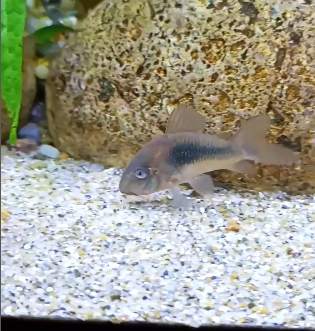
Do Bronze Cory Eat Algae?
As omnivores, Bronze Corys may consume some algae as part of their varied diet, but it is not a significant component of their nutritional intake. They are primarily bottom feeders and will be more interested in sifting through the substrate in search of food, rather than grazing on algae.
Do Bronze Cory Eat Shrimp?
Bronze Corys can coexist with larger ornamental shrimp and most other peaceful invertebrates in the home aquarium. However, they are known to prey on small dwarf shrimp juveniles. Therefore, it is essential to consider the size and species of shrimp before incorporating them into a tank with Bronze Corys.
Do Bronze Cory Eat Bloodworms?
Bloodworms are among the favorite live foods for Bronze Corys. They can be offered freeze-dried, frozen, or as a live treat and are typically well-received as part of a balanced diet. Feeders should make sure these foods reach the bottom of the tank, given that Bronze Corys tend to ignore foods floating on the surface due to their bottom-feeding nature.
Do Bronze Cory Eat Mosquito Larvae?
Indeed, Bronze Corys do consume mosquito larvae, which can be offered as part of a varied and balanced diet in a home aquarium. Just like with other live foods, mosquito larvae should be introduced to the bottom of the tank, where these catfish can forage for them.
Do Bronze Cory Eat Planaria?
While Bronze Corys mainly feed on small crustaceans, worms, and insects, they may consume planaria if encountered while foraging in the substrate. However, planaria are not a specific staple in their diet, and due care should be taken to maintain a clean and healthy aquarium environment to minimize the presence of unwanted pests like planaria.
Do Bronze Cory Eat Plants?
Bronze Corys do not eat aquarium plants. They may inadvertently uproot small or delicate plants while searching for food along the substrate, but their interaction with plants is generally without malice. Plant matter is not actively sought after by these catfish, and they should be provided with a balanced diet that includes meaty foods and suitable vegetable-based treats.
Sexing: Male vs Female
Sexing Bronze Corys can be straightforward once they reach adulthood. Discerning the gender of these peaceful schooling fish involves observing body shape and fin structure.
Adult females typically exhibit a fuller body profile when viewed from above. Specifically, they appear wider behind the dorsal fin—a stark contrast to the slender build of adult males in the same area. This size difference is substantial, with females boasting about 20 percent more body mass compared to their male counterparts.
When examining the fins, another distinctive feature becomes apparent: the ventral fins. Males possess more pointed ventral fins, while females have fins that are more paddle-shaped, further aiding aquarists in sex identification.
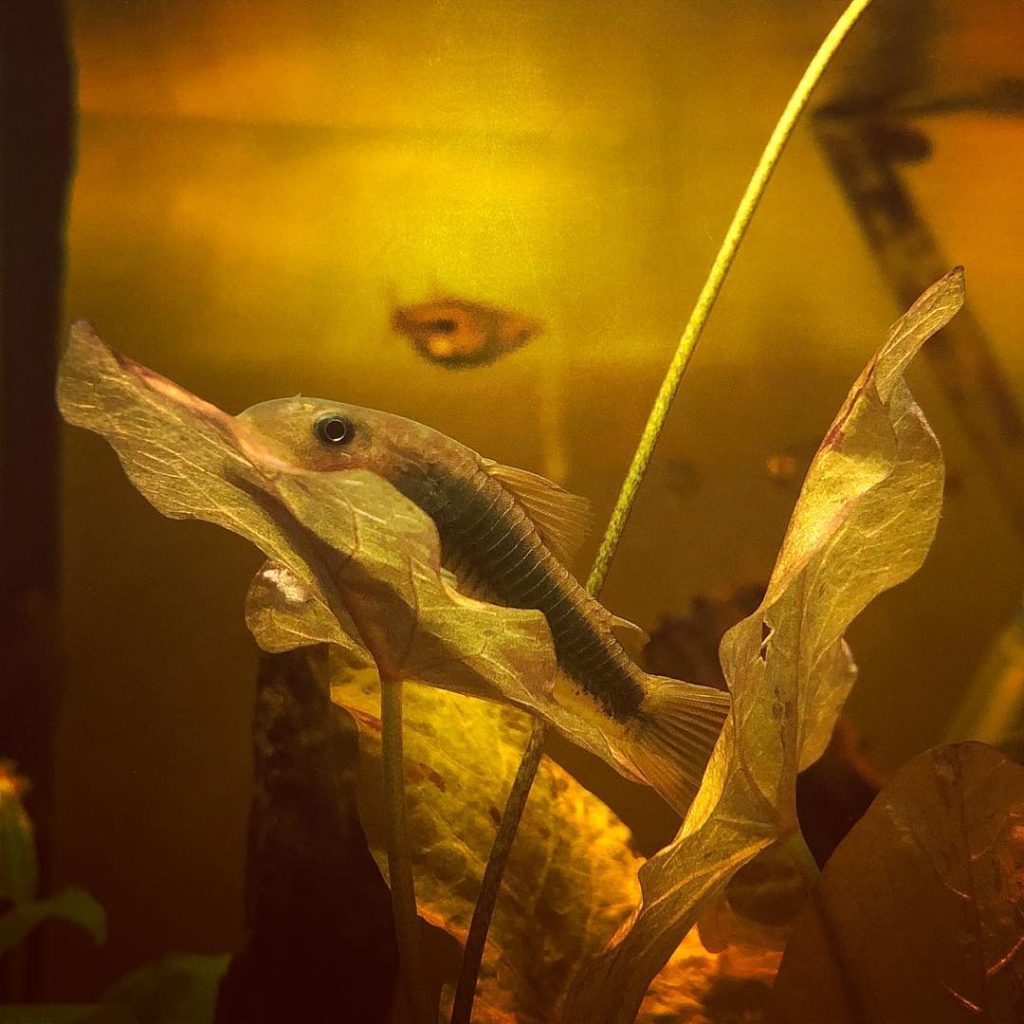
Adult Bronze Corys can often be sexed by noting body size and fin shape:
- Females: Wider build behind dorsal fin, larger body mass, paddle-shaped ventral fins.
- Males: Slimmer profile behind dorsal fin, more pointed ventral fins.
By taking these visual cues into account, hobbyists can easily distinguish between male and female Bronze Corys within their freshwater aquarium community.
Bronze Cory Tank Mates
Keeping Bronze Corys in a community aquarium requires careful consideration of tank mates. As peaceful schooling fish hailing from the shallow waters of South America, Bronze Corys thrive in groups of five or more. Their tranquil nature and tendency to search the bottom for food make them compatible with other non-aggressive fish.
Tank mates that suit Bronze Corys are species that share their friendly disposition. Otocinclus catfish, a variety of tetras, swordtails, and fellow corydoras can create a harmonious aquatic community. It’s essential to steer clear of pairing them with bellicose fish like oscars, Texas cichlids, or Jack Dempseys. Such aggressive fish may harm or even consume the smaller, less assertive Bronze Corys.
For an ideal habitat that mimics the Bronze Corys’ natural environment, a well-planted tank with driftwood and a soft sandy substrate is recommended. This ensures a comfortable terrain for their barbels while foraging and maintains high-quality water conditions.
Potential Tank Mates for Bronze Corys
- Otocinclus Catfish
- Various Tetras
- Swordtails
- Other Corydoras Species
Avoid aggressive and larger fish that may prey on the Bronze Corys to ensure a peaceful coexistence within your freshwater aquarium.
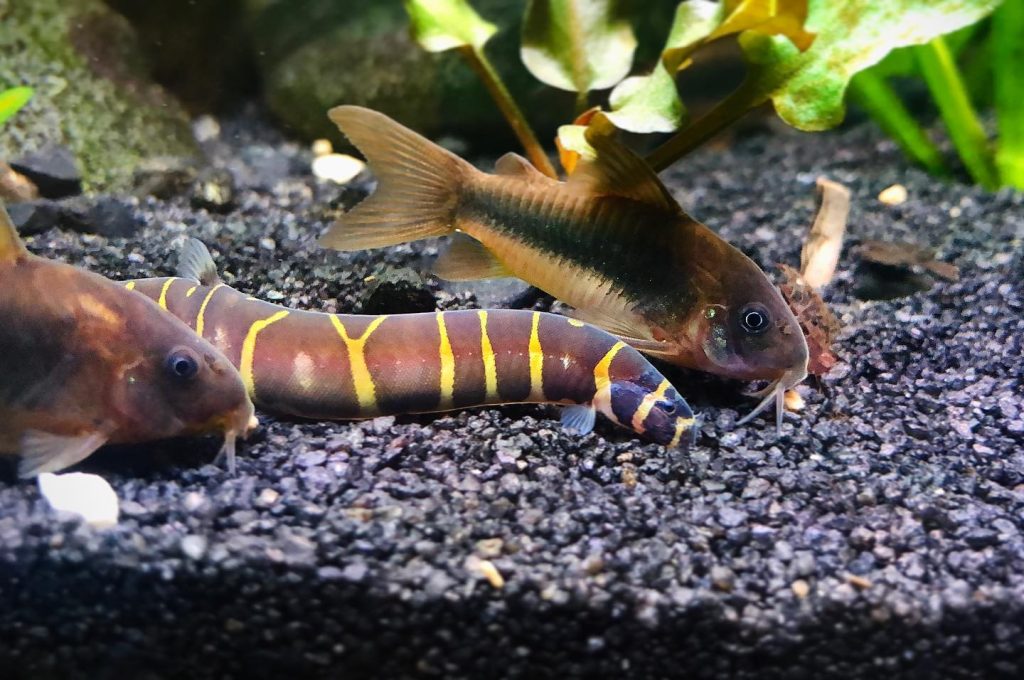
Aquarium Setup
Creating the perfect home for Bronze Corydoras, commonly known as Bronze Corys, necessitates replicating their natural habitat to provide a safe, comfortable, and enriching environment. Native to the tranquil, shallow waters of South America, particularly in areas with muddy bottoms, Bronze Corys are adaptive to a variety of water conditions and are known to be one of the most popular catfish among aquarium enthusiasts.
Ideal Tank Size
When considering tank size for your peaceful schooling fish, it’s important to take into account both their need to school and their active bottom-dwelling behavior. The recommended minimum tank size for Bronze Corys varies somewhat, but a general rule is a minimum tank size of 15 to 20 gallons for a group of five to six individuals. Larger groups will require proportionally larger tanks to ensure adequate space for all members to swim and forage comfortably. While a 12-gallon tank may suffice for a small group, opting for a larger space whenever possible is beneficial for their overall health and well-being.
Ideal Water Parameters
Water parameters play a vital role in keeping your Bronze Corys healthy. These peaceful schooling fish prefer freshwater with tropical temperatures ranging between 25 and 28 degrees Celsius (77-82°F). Water pH should be maintained between 6.0 and 7.5 to match the slightly acidic to neutral conditions of their natural habitat. It’s paramount to keep ammonia and nitrite levels at 0ppm to prevent any harm to your fish. Additionally, nitrate levels should be kept below 30ppm to safeguard their health.
Filtration
Even though Bronze Corys are native to waters that might be slow-moving or even stagnant, filtration is crucial in an aquarium to maintain high water quality and clarity. The ideal filtration system creates sufficient water turnover to keep the environment clean while not generating a strong current that could stress these armored catfishes. An HOB (Hang On Back) filter like the Aquaclear Power Filter is recommended, thanks to its gentle flow and customizable filtration media.
Lighting
The Bronze Cory does not have specific lighting needs, but moderate lighting conditions can replicate the diffuse light of their natural habitat, often shadowed by dense canopy. Subdued or low-level lighting not only emulates the dimly-lit South American rivers but also may encourage more natural behavior and relieve stress. Proper lighting can also benefit live plants in the tank, such as Aponogeton, which can thrive under a variety of lighting conditions and provide excellent hiding spots for Bronze Corys.
When arranging the tank setup for Bronze Corys, consider the inclusion of smooth sand substrate to protect their delicate barbels and the incorporation of plants and driftwood to simulate the complexity of their natural environment. Careful consideration of all these factors will ensure your Bronze Corys have a habitat where they can thrive and exhibit their charming behavior.
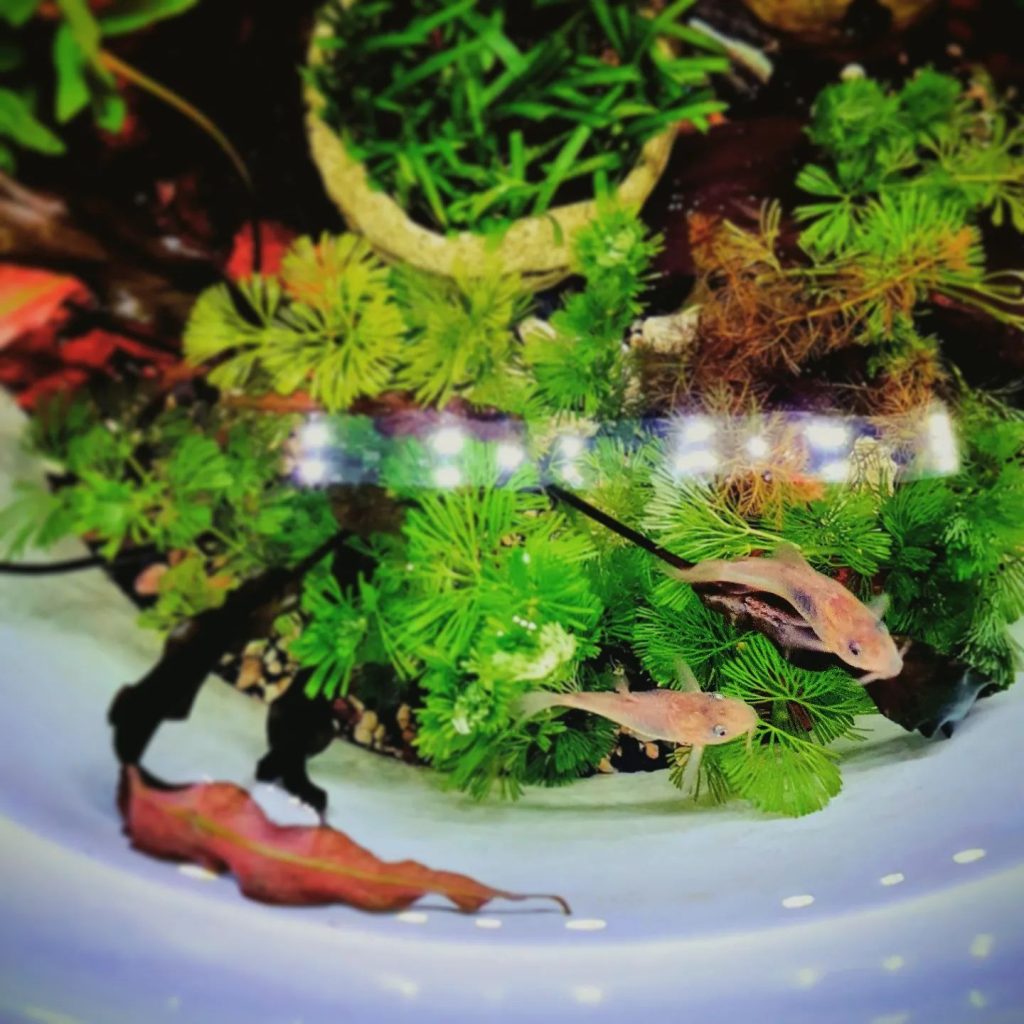
Common Possible Diseases & Prevention
Maintaining the health of Bronze Corys, like all freshwater aquarium inhabitants, involves preventing and identifying common diseases. The Bronze Cory, despite its hardy nature, can fall prey to ailments such as ich, fin rot, and columnaris. These conditions often result from suboptimal water quality, stress, or improper nutrition.
To safeguard against these diseases, it’s essential to:
- Maintain Optimal Water Quality: Regular water changes and testing will keep harmful chemicals in check.
- Provide a Balanced Diet: Alternating between high-quality flake food, pellet food, frozen foods, and live options like brine shrimp ensures a nutritious diet.
- Conduct Regular Tank Maintenance: Cleaning the tank and equipment helps prevent pathogen buildup.
- Quarantine New Fish: Isolate newcomers for at least two weeks to observe for signs of illness.
- Acclimate Fish Properly: Gradually introduce new fish to the tank to minimize stress.
- Monitor Fish Regularly: Watch for behavioral changes or physical symptoms of disease for early detection and treatment.
Adhering to these prevention measures will enhance the resilience of Bronze Corys to health issues, ensuring they remain lively and animated members of the aquarium community.

Breeding Bronze Cory in Aquarium
Breeding Bronze Corydoras, or Bronze Corys, can be an exciting endeavor for freshwater aquarium enthusiasts. To increase the chances of successful procreation, aim for a breeding ratio of two males for every female in the tank. Signs that females are ready include a visibly plumper abdomen filled with eggs.
To encourage mating, simulate their natural habitat’s rainy season. This can be done with a substantial water change using slightly cooler water or through consecutive days of slight water changes. Soon after these changes, males may start avidly pursuing the females—a courtship dance that can continue for a prolonged period.
Here’s a simple guide to assist with breeding Bronze Corys:
| Step | Action |
|---|---|
| Check Readiness | Watch for females becoming round with eggs. |
| Adjust Ratio | Ensure two males per female in the breeding tank. |
| Simulate Rainy Season | Perform large cool water change or daily small changes. |
| Observe Behavior | Look for males chasing females, signaling mating onset. |
Once breeding occurs, the community aquarium aspect of these peaceful schooling fish ensures compatibility with most nano aquarium species, making the Bronze Cory a superb choice for a diverse and harmonious display.


